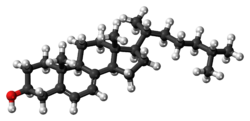7-Dehydrocholesterol

| |

| |
| Names | |
|---|---|
| IUPAC name
Cholesta-5,7-dien-3β-ol
| |
| Systematic IUPAC name
(1R,3aR,7S,9aR,9bS,11aR)-9a,11a-Dimethyl-1-[(2R)-6-methylheptan-2-yl]-2,3,3a,6,7,8,9,9a,9b,10,11,11a-dodecahydro-1H-cyclopenta[a]phenanthren-7-ol | |
| Identifiers | |
3D model (
JSmol ) |
|
| ChEBI | |
| ChemSpider | |
ECHA InfoCard
|
100.006.456 |
| MeSH | 7-dehydrocholesterol |
PubChem CID
|
|
| UNII | |
CompTox Dashboard (EPA)
|
|
| |
| |
| Properties | |
| C27H44O | |
| Molar mass | 384.638 |
Except where otherwise noted, data are given for materials in their standard state (at 25 °C [77 °F], 100 kPa).
| |

7-Dehydrocholesterol (7-DHC) is a
Biosynthesis
It is synthesized from
Location
The skin consists of two primary layers: an inner layer, the
Radiation
Synthesis of pre-vitamin D3 in the skin involves
Another important consideration is the quantity of 7-dehydrocholesterol present in the skin. Under normal circumstances, ample quantities of 7-dehydrocholesterol (about 25–50 μg/cm2 of skin) are available in the stratum spinosum and stratum basale of human skin to meet the body's vitamin D requirements. 7-DHC insufficiency has been proposed as an alternate cause for Vitamin D deficiency.[10]
Sources
7-DHC can be produced by animals and plants via different pathways. It is not produced by fungi in significant amounts. It is made by some algae, but the pathway is poorly understood.[11] It can also be produced by some bacteria.[10]
Industrially, 7-DHC generally comes from
7-DHC is used for vitamin D3 synthesis via lanosterol in land animals, via cycloartenol in plants, and in algae together with another provitamin D ergosterol for D2. In fungi solely ergosterol is used for synthesis of D2 via lanosterol.[15]
Interactive pathway map
Click on genes, proteins and metabolites below to link to respective articles. [§ 1]
- ^ The interactive pathway map can be edited at WikiPathways: "VitaminDSynthesis_WP1531".
See also
References
- ^ "7-dehydrocholesterol". The American Heritage Stedman's Medical Dictionary. Houghton Mifflin Company. 21 January 2007.
- ^ "7-dehydrocholesterol". Answers.com. Archived from the original on 25 October 2012.
- ^ Young E (2012). "Thanks to one gene, this fly needs a cactus to escape Neverland". Not Exactly Rocket Science. Archived from the original on 2012-09-30. Retrieved 2012-09-28.
- ^ PMID 12812989.
- S2CID 206502190.
- ISBN 0-8053-7211-3.
- ^ PMID 9625080.
- PMID 6281884.
- PMID 28904394.
- ^ PMID 31848400.
- PMID 23717318.
- PMID 16251641.
[Vitamin D3] is produced commercially by extracting 7-dehydrocholesterol from wool fat, followed by UVB irradiation and purification [...] [Vitamin D2] is commercially made by irradiating and then purifying the ergosterol extracted from yeast
- ^ "Vitamin D". The Vegan Society.
- ^ Gangwar, Gourvendra (1 July 2023). "Formulation of Lichen Based Pill a Natural Source of Vitamin D3 with a High Absorption Rate by Ambrosiya Neo-Medicine Pvt. Ltd". International Journal of Biomedical Investigation: 1.
- S2CID 53437216. Retrieved December 2, 2023.

